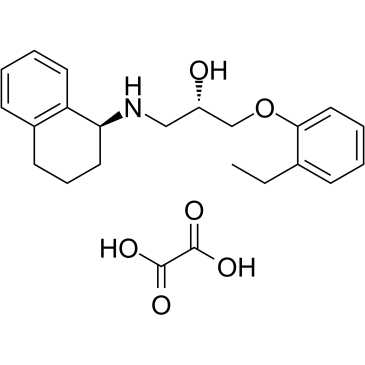
SR59230A
CAS No. 174689-39-5
SR59230A( —— )
Catalog No. M21725 CAS No. 174689-39-5
MDMA (20 mg/kg) produces a slowly developing hyperthermia, reaching a maximum increase of 1.8°C at 130 min post injection.
Purity : >98% (HPLC)
 COA
COA
 Datasheet
Datasheet
 HNMR
HNMR
 HPLC
HPLC
 MSDS
MSDS
 Handing Instructions
Handing Instructions
| Size | Price / USD | Stock | Quantity |
| 2MG | 63 | In Stock |


|
| 5MG | 98 | In Stock |


|
| 10MG | 164 | In Stock |


|
| 25MG | 325 | In Stock |


|
| 50MG | 483 | In Stock |


|
| 100MG | 698 | In Stock |


|
| 200MG | Get Quote | In Stock |


|
| 500MG | Get Quote | In Stock |


|
| 1G | Get Quote | In Stock |


|
Biological Information
-
Product NameSR59230A
-
NoteResearch use only, not for human use.
-
Brief DescriptionMDMA (20 mg/kg) produces a slowly developing hyperthermia, reaching a maximum increase of 1.8°C at 130 min post injection.
-
DescriptionMDMA (20 mg/kg) produces a slowly developing hyperthermia, reaching a maximum increase of 1.8°C at 130 min post injection. SR59230A (0.5 mg/kg) produces a small but significant attenuation of the slowly developing hyperthermia to MDMA. SR59230A (5 mg/kg) reveals a significant and marked early hypothermic reaction to MDMA.
-
In VitroSR59230A (100 nM-50 μM; 24 hours) is able to reduce cell viability in a dose-dependent manner in Neuro-2A, BE(2)C and SK-N-BE(2) NB cell lines. Cell Viability Assay Cell Line:Three different neuroblastoma (NB) cell lines, one murine (Neuro-2A) and two human (SK-N-BE(2), BE(2)C)Concentration:100 nM, 1 μM, 5 μM, 10 μM, and 50 μM Incubation Time:24 hours Result:Reduced cell viability in a dose-dependent manner, with significant effect at a concentration limit over 1?μM for Neuro-2A cells and 5?μM for SK-N-BE(2) and BE(2)C).
-
In VivoMDMA (20 mg/kg) produces a slowly developing hyperthermia, reaching a maximum increase of 1.8°C at 130 min post injection. SR59230A (0.5 mg/kg) produces a small but significant attenuation of the slowly developing hyperthermia to MDMA. SR59230A (5 mg/kg) reveals a significant and marked early hypothermic reaction to MDMA. Animal Model:Male C-57BL6J wild-type mice (22-35 g)Dosage:0.5 or 5 mg/kg Administration:Injected s.c.; administered 30 min prior to the injection s.c. of MDMA (20 mg/kg).Result:Modulated the actions of MDMA on temperature involve α1-adrenoceptor antagonism.
-
Synonyms——
-
PathwayAngiogenesis
-
TargetAdrenergic Receptor
-
Recptor——
-
Research Area——
-
Indication——
Chemical Information
-
CAS Number174689-39-5
-
Formula Weight415.48
-
Molecular FormulaC??H??NO?
-
Purity>98% (HPLC)
-
SolubilityDMSO : 31.25 mg/mL (75.21 mM; Need ultrasonic)
-
SMILESO[C@@H](CN[C@H]1CCCC2=C1C=CC=C2)COC3=CC=CC=C3CC.O=C(O)C(O)=O
-
Chemical Name——
Shipping & Storage Information
-
Storage(-20℃)
-
ShippingWith Ice Pack
-
Stability≥ 2 years
Reference
1. Nisoli E, et al. Functional studies of the first selective beta 3-adrenergic receptor antagonist SR 59230A in rat brown adipocytes.Mol Pharmacol. 1996 Jan;49(1):7-14.
2. Kanzler SA, et al. Involvement of β3-adrenergic receptors in the control of food intake in rats.Braz J Med Biol Res. 2011 Nov;44(11):1141-7.
3. Bruno G, et al. β3-adrenoreceptor blockade reduces tumor growth and increases neuronal differentiation in neuroblastoma via SK2/S1P2 modulation.Oncogene. 2020 Jan;39(2):368-384.
molnova catalog



related products
-
Bupranolol
Bupranolol is an antagonist of β2-adrenergic receptor,and has been used for angina pectoris, hypertension, glaucoma, cardiac arrhythmia and as an antithrombotic.
-
SR59230A
MDMA (20 mg/kg) produces a slowly developing hyperthermia, reaching a maximum increase of 1.8°C at 130 min post injection.
-
DL-071-IT
DL 071-IT is a potent non-selective beta-adrenoceptor antagonist. DL 071 IT showed intrinsic sympathomimetic activity and weak membrane stabilizing activity.



 Cart
Cart
 sales@molnova.com
sales@molnova.com


